Nutrition Promotion and Education Report: Preschoolers in Melbourne
VerifiedAdded on 2023/01/18
|17
|3971
|88
Report
AI Summary
This report presents a detailed nutrition promotion and education plan designed for preschool children in a low socioeconomic position (SEP) suburb of Melbourne, Australia. The report begins with an introduction that establishes the importance of proper nutrition for preschool children, highlighting the potential consequences of inadequate nutrition on their development. It provides a brief overview of the target population, which includes 3- to 4-year-old children attending daycare centers and kindergartens. The report then delves into the influences on eating behavior, including activity and creativity, parental behavior, and socioeconomic status, and explains how these factors impact the children's food choices. It also incorporates Lewin's Change Management model to guide the session plan, outlining the unfreeze, change, and refreeze stages. The report further integrates various learning principles, such as social learning, cognitivism, constructivism, and demonstrative/kinesthetic approaches, to maximize the effectiveness of the educational interventions. The session plan components are described, including strategies and elements for each week, and a follow-up evaluation is proposed to assess the impact of the program. The report concludes with an analysis and conclusion, summarizing the key findings and recommendations for promoting healthy eating habits among preschool children and their parents.
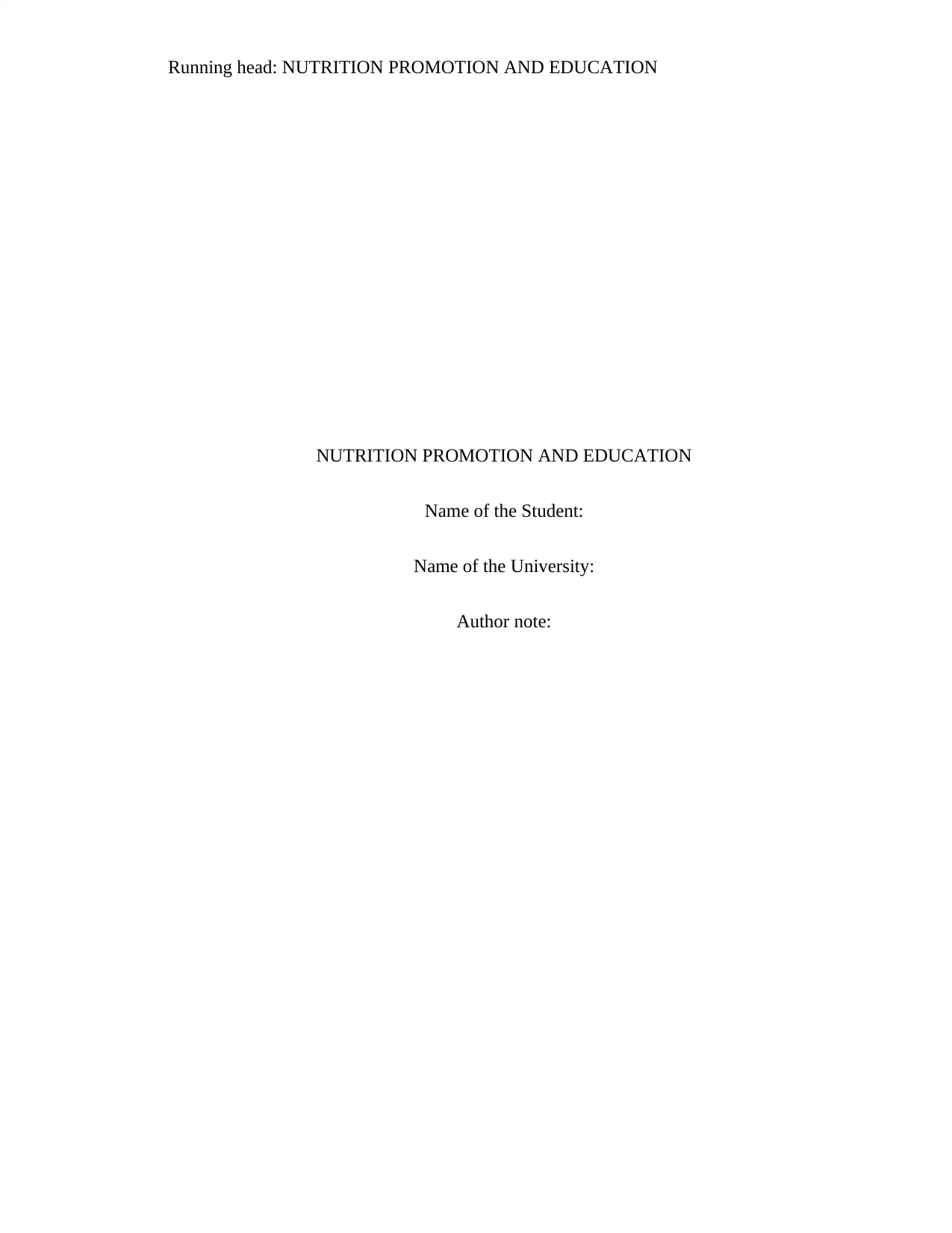
Running head: NUTRITION PROMOTION AND EDUCATION
NUTRITION PROMOTION AND EDUCATION
Name of the Student:
Name of the University:
Author note:
NUTRITION PROMOTION AND EDUCATION
Name of the Student:
Name of the University:
Author note:
Paraphrase This Document
Need a fresh take? Get an instant paraphrase of this document with our AI Paraphraser
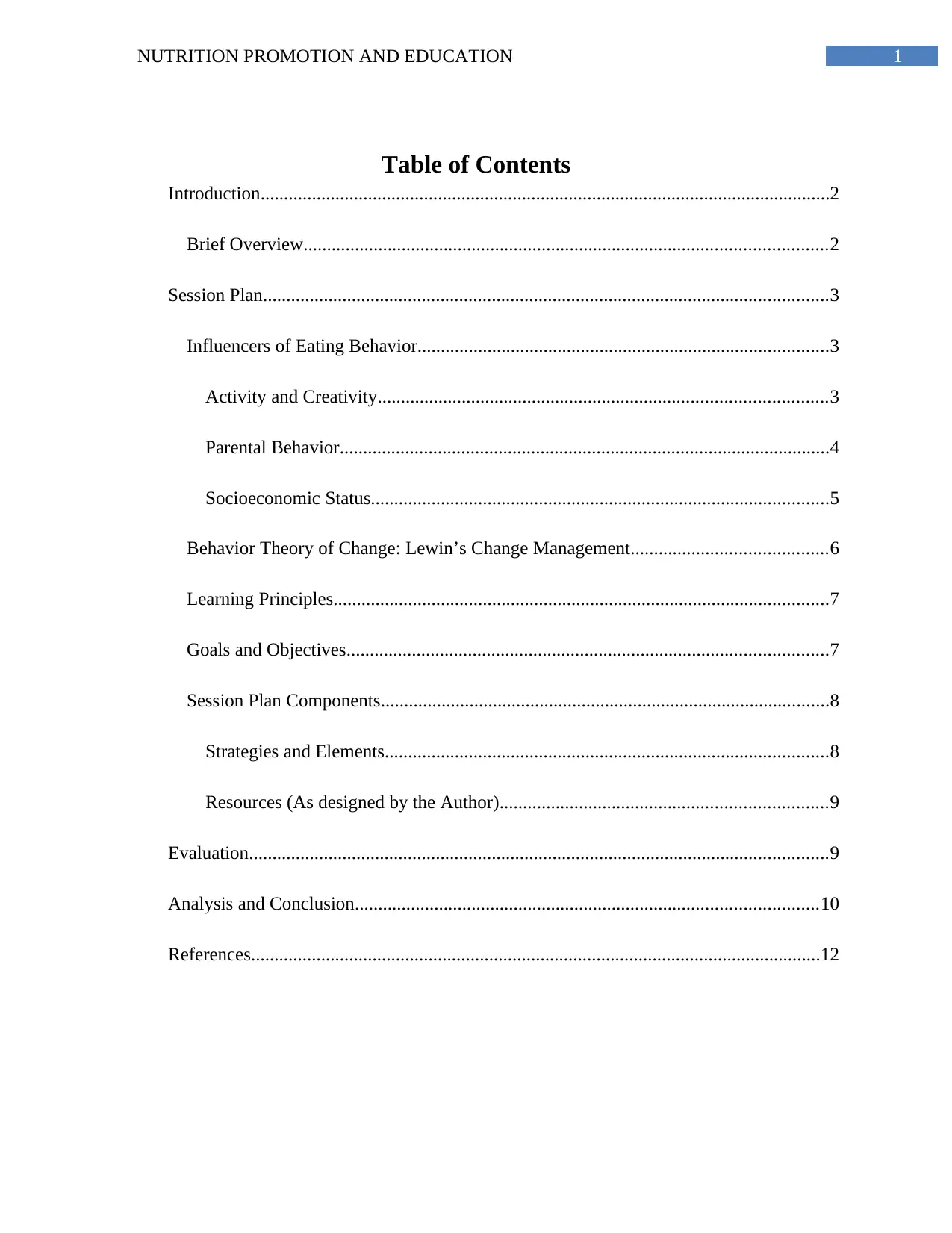
1NUTRITION PROMOTION AND EDUCATION
Table of Contents
Introduction..........................................................................................................................2
Brief Overview................................................................................................................2
Session Plan.........................................................................................................................3
Influencers of Eating Behavior........................................................................................3
Activity and Creativity................................................................................................3
Parental Behavior.........................................................................................................4
Socioeconomic Status..................................................................................................5
Behavior Theory of Change: Lewin’s Change Management..........................................6
Learning Principles..........................................................................................................7
Goals and Objectives.......................................................................................................7
Session Plan Components................................................................................................8
Strategies and Elements...............................................................................................8
Resources (As designed by the Author)......................................................................9
Evaluation............................................................................................................................9
Analysis and Conclusion...................................................................................................10
References..........................................................................................................................12
Table of Contents
Introduction..........................................................................................................................2
Brief Overview................................................................................................................2
Session Plan.........................................................................................................................3
Influencers of Eating Behavior........................................................................................3
Activity and Creativity................................................................................................3
Parental Behavior.........................................................................................................4
Socioeconomic Status..................................................................................................5
Behavior Theory of Change: Lewin’s Change Management..........................................6
Learning Principles..........................................................................................................7
Goals and Objectives.......................................................................................................7
Session Plan Components................................................................................................8
Strategies and Elements...............................................................................................8
Resources (As designed by the Author)......................................................................9
Evaluation............................................................................................................................9
Analysis and Conclusion...................................................................................................10
References..........................................................................................................................12

2NUTRITION PROMOTION AND EDUCATION
⊘ This is a preview!⊘
Do you want full access?
Subscribe today to unlock all pages.

Trusted by 1+ million students worldwide
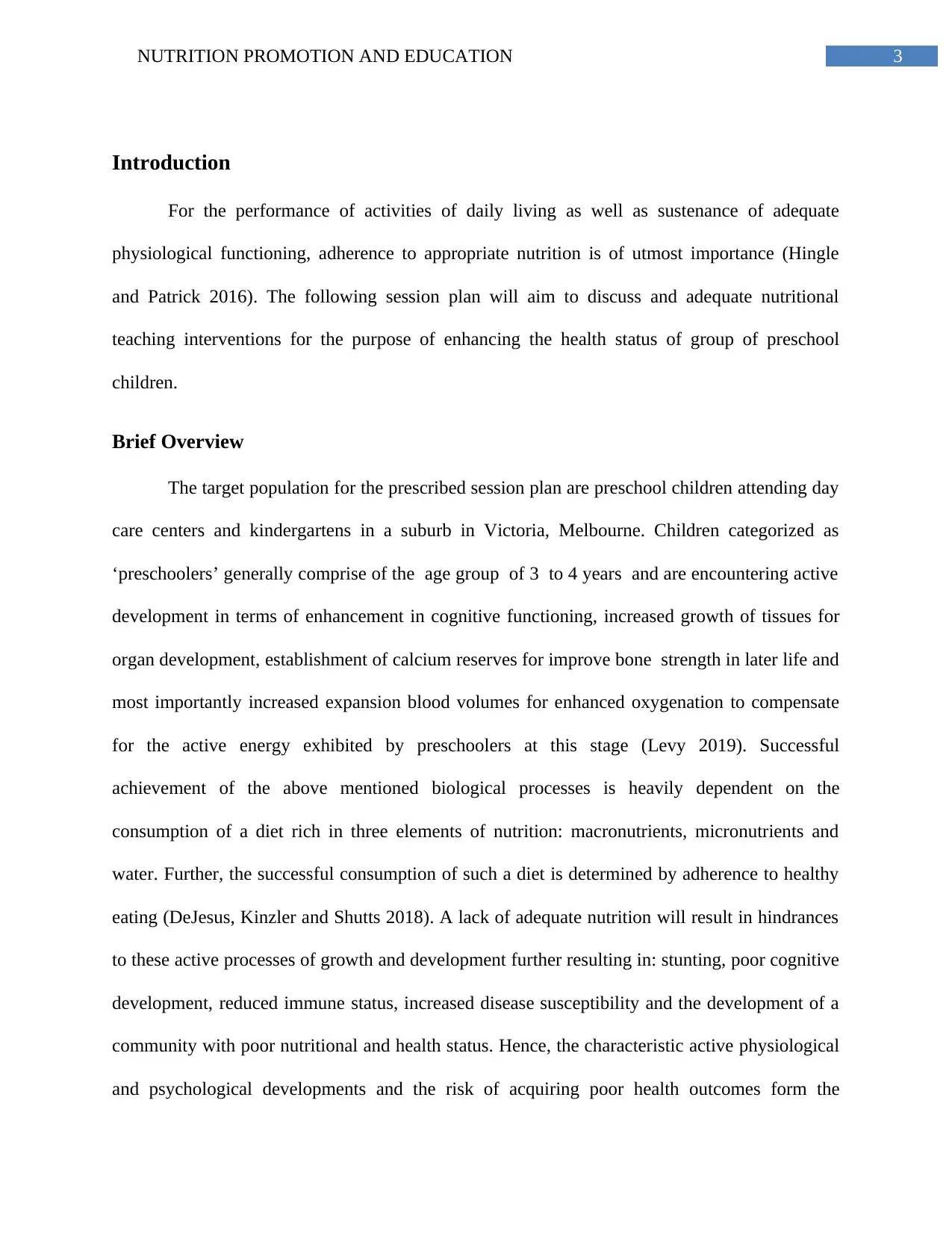
3NUTRITION PROMOTION AND EDUCATION
Introduction
For the performance of activities of daily living as well as sustenance of adequate
physiological functioning, adherence to appropriate nutrition is of utmost importance (Hingle
and Patrick 2016). The following session plan will aim to discuss and adequate nutritional
teaching interventions for the purpose of enhancing the health status of group of preschool
children.
Brief Overview
The target population for the prescribed session plan are preschool children attending day
care centers and kindergartens in a suburb in Victoria, Melbourne. Children categorized as
‘preschoolers’ generally comprise of the age group of 3 to 4 years and are encountering active
development in terms of enhancement in cognitive functioning, increased growth of tissues for
organ development, establishment of calcium reserves for improve bone strength in later life and
most importantly increased expansion blood volumes for enhanced oxygenation to compensate
for the active energy exhibited by preschoolers at this stage (Levy 2019). Successful
achievement of the above mentioned biological processes is heavily dependent on the
consumption of a diet rich in three elements of nutrition: macronutrients, micronutrients and
water. Further, the successful consumption of such a diet is determined by adherence to healthy
eating (DeJesus, Kinzler and Shutts 2018). A lack of adequate nutrition will result in hindrances
to these active processes of growth and development further resulting in: stunting, poor cognitive
development, reduced immune status, increased disease susceptibility and the development of a
community with poor nutritional and health status. Hence, the characteristic active physiological
and psychological developments and the risk of acquiring poor health outcomes form the
Introduction
For the performance of activities of daily living as well as sustenance of adequate
physiological functioning, adherence to appropriate nutrition is of utmost importance (Hingle
and Patrick 2016). The following session plan will aim to discuss and adequate nutritional
teaching interventions for the purpose of enhancing the health status of group of preschool
children.
Brief Overview
The target population for the prescribed session plan are preschool children attending day
care centers and kindergartens in a suburb in Victoria, Melbourne. Children categorized as
‘preschoolers’ generally comprise of the age group of 3 to 4 years and are encountering active
development in terms of enhancement in cognitive functioning, increased growth of tissues for
organ development, establishment of calcium reserves for improve bone strength in later life and
most importantly increased expansion blood volumes for enhanced oxygenation to compensate
for the active energy exhibited by preschoolers at this stage (Levy 2019). Successful
achievement of the above mentioned biological processes is heavily dependent on the
consumption of a diet rich in three elements of nutrition: macronutrients, micronutrients and
water. Further, the successful consumption of such a diet is determined by adherence to healthy
eating (DeJesus, Kinzler and Shutts 2018). A lack of adequate nutrition will result in hindrances
to these active processes of growth and development further resulting in: stunting, poor cognitive
development, reduced immune status, increased disease susceptibility and the development of a
community with poor nutritional and health status. Hence, the characteristic active physiological
and psychological developments and the risk of acquiring poor health outcomes form the
Paraphrase This Document
Need a fresh take? Get an instant paraphrase of this document with our AI Paraphraser
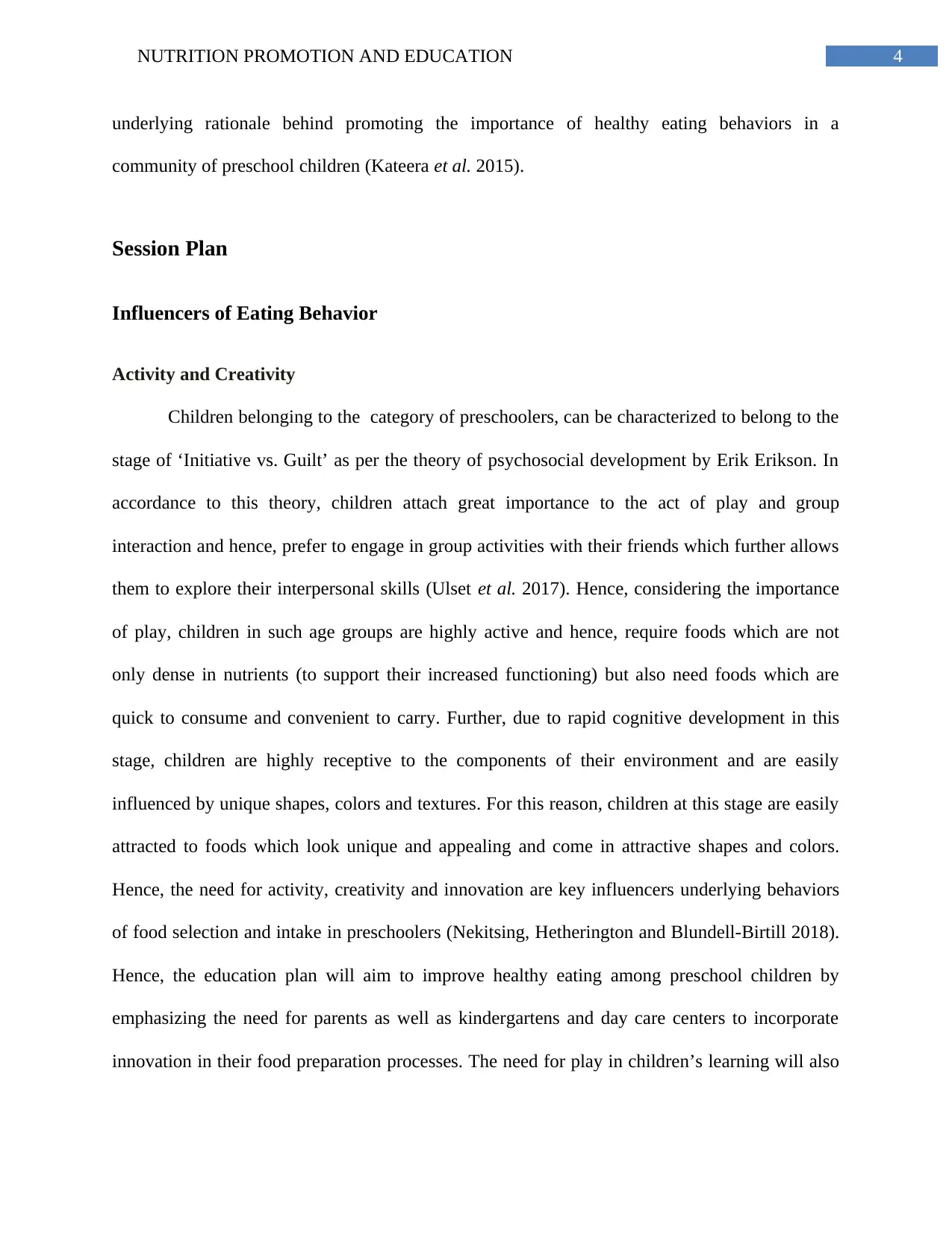
4NUTRITION PROMOTION AND EDUCATION
underlying rationale behind promoting the importance of healthy eating behaviors in a
community of preschool children (Kateera et al. 2015).
Session Plan
Influencers of Eating Behavior
Activity and Creativity
Children belonging to the category of preschoolers, can be characterized to belong to the
stage of ‘Initiative vs. Guilt’ as per the theory of psychosocial development by Erik Erikson. In
accordance to this theory, children attach great importance to the act of play and group
interaction and hence, prefer to engage in group activities with their friends which further allows
them to explore their interpersonal skills (Ulset et al. 2017). Hence, considering the importance
of play, children in such age groups are highly active and hence, require foods which are not
only dense in nutrients (to support their increased functioning) but also need foods which are
quick to consume and convenient to carry. Further, due to rapid cognitive development in this
stage, children are highly receptive to the components of their environment and are easily
influenced by unique shapes, colors and textures. For this reason, children at this stage are easily
attracted to foods which look unique and appealing and come in attractive shapes and colors.
Hence, the need for activity, creativity and innovation are key influencers underlying behaviors
of food selection and intake in preschoolers (Nekitsing, Hetherington and Blundell-Birtill 2018).
Hence, the education plan will aim to improve healthy eating among preschool children by
emphasizing the need for parents as well as kindergartens and day care centers to incorporate
innovation in their food preparation processes. The need for play in children’s learning will also
underlying rationale behind promoting the importance of healthy eating behaviors in a
community of preschool children (Kateera et al. 2015).
Session Plan
Influencers of Eating Behavior
Activity and Creativity
Children belonging to the category of preschoolers, can be characterized to belong to the
stage of ‘Initiative vs. Guilt’ as per the theory of psychosocial development by Erik Erikson. In
accordance to this theory, children attach great importance to the act of play and group
interaction and hence, prefer to engage in group activities with their friends which further allows
them to explore their interpersonal skills (Ulset et al. 2017). Hence, considering the importance
of play, children in such age groups are highly active and hence, require foods which are not
only dense in nutrients (to support their increased functioning) but also need foods which are
quick to consume and convenient to carry. Further, due to rapid cognitive development in this
stage, children are highly receptive to the components of their environment and are easily
influenced by unique shapes, colors and textures. For this reason, children at this stage are easily
attracted to foods which look unique and appealing and come in attractive shapes and colors.
Hence, the need for activity, creativity and innovation are key influencers underlying behaviors
of food selection and intake in preschoolers (Nekitsing, Hetherington and Blundell-Birtill 2018).
Hence, the education plan will aim to improve healthy eating among preschool children by
emphasizing the need for parents as well as kindergartens and day care centers to incorporate
innovation in their food preparation processes. The need for play in children’s learning will also
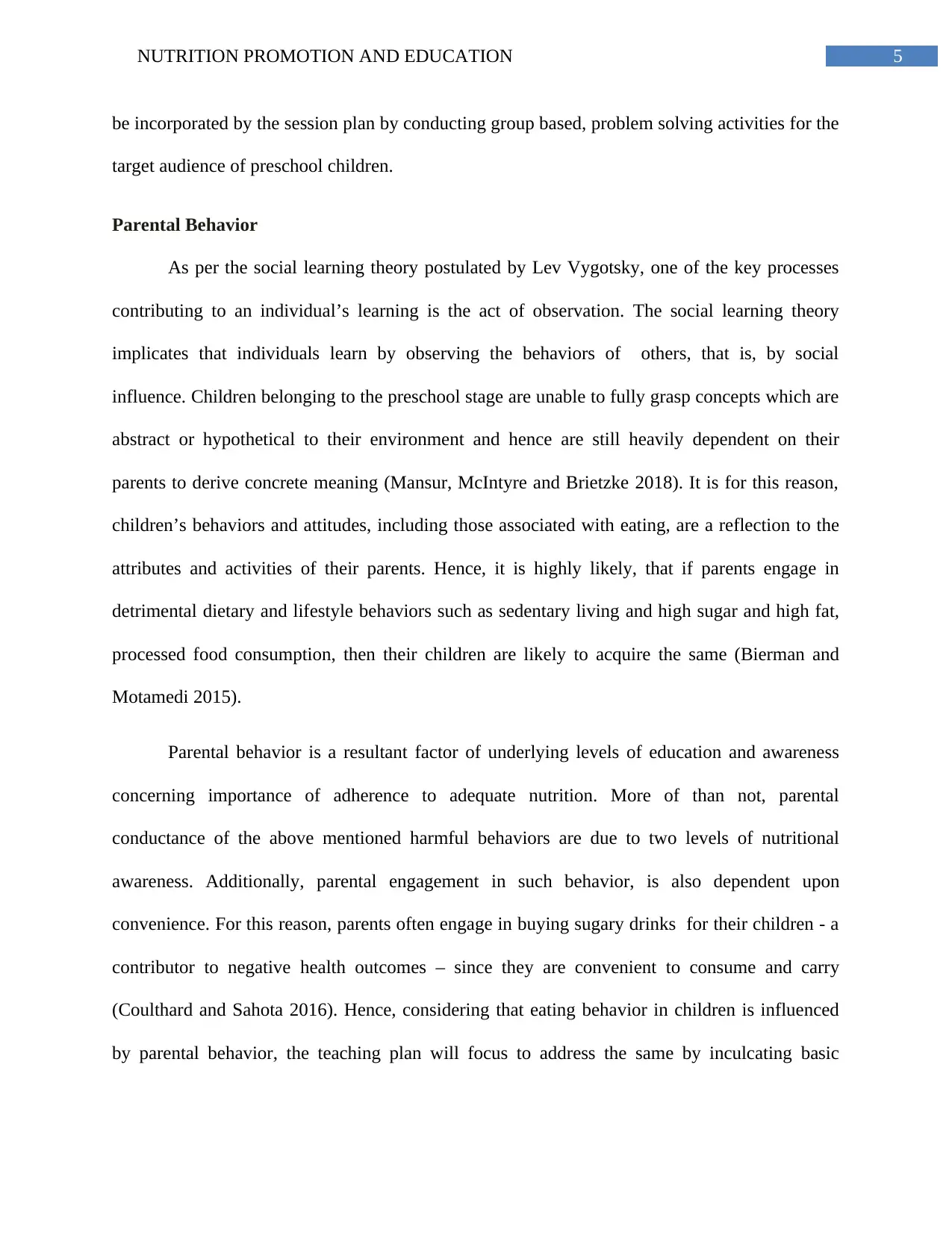
5NUTRITION PROMOTION AND EDUCATION
be incorporated by the session plan by conducting group based, problem solving activities for the
target audience of preschool children.
Parental Behavior
As per the social learning theory postulated by Lev Vygotsky, one of the key processes
contributing to an individual’s learning is the act of observation. The social learning theory
implicates that individuals learn by observing the behaviors of others, that is, by social
influence. Children belonging to the preschool stage are unable to fully grasp concepts which are
abstract or hypothetical to their environment and hence are still heavily dependent on their
parents to derive concrete meaning (Mansur, McIntyre and Brietzke 2018). It is for this reason,
children’s behaviors and attitudes, including those associated with eating, are a reflection to the
attributes and activities of their parents. Hence, it is highly likely, that if parents engage in
detrimental dietary and lifestyle behaviors such as sedentary living and high sugar and high fat,
processed food consumption, then their children are likely to acquire the same (Bierman and
Motamedi 2015).
Parental behavior is a resultant factor of underlying levels of education and awareness
concerning importance of adherence to adequate nutrition. More of than not, parental
conductance of the above mentioned harmful behaviors are due to two levels of nutritional
awareness. Additionally, parental engagement in such behavior, is also dependent upon
convenience. For this reason, parents often engage in buying sugary drinks for their children - a
contributor to negative health outcomes – since they are convenient to consume and carry
(Coulthard and Sahota 2016). Hence, considering that eating behavior in children is influenced
by parental behavior, the teaching plan will focus to address the same by inculcating basic
be incorporated by the session plan by conducting group based, problem solving activities for the
target audience of preschool children.
Parental Behavior
As per the social learning theory postulated by Lev Vygotsky, one of the key processes
contributing to an individual’s learning is the act of observation. The social learning theory
implicates that individuals learn by observing the behaviors of others, that is, by social
influence. Children belonging to the preschool stage are unable to fully grasp concepts which are
abstract or hypothetical to their environment and hence are still heavily dependent on their
parents to derive concrete meaning (Mansur, McIntyre and Brietzke 2018). It is for this reason,
children’s behaviors and attitudes, including those associated with eating, are a reflection to the
attributes and activities of their parents. Hence, it is highly likely, that if parents engage in
detrimental dietary and lifestyle behaviors such as sedentary living and high sugar and high fat,
processed food consumption, then their children are likely to acquire the same (Bierman and
Motamedi 2015).
Parental behavior is a resultant factor of underlying levels of education and awareness
concerning importance of adherence to adequate nutrition. More of than not, parental
conductance of the above mentioned harmful behaviors are due to two levels of nutritional
awareness. Additionally, parental engagement in such behavior, is also dependent upon
convenience. For this reason, parents often engage in buying sugary drinks for their children - a
contributor to negative health outcomes – since they are convenient to consume and carry
(Coulthard and Sahota 2016). Hence, considering that eating behavior in children is influenced
by parental behavior, the teaching plan will focus to address the same by inculcating basic
⊘ This is a preview!⊘
Do you want full access?
Subscribe today to unlock all pages.

Trusted by 1+ million students worldwide
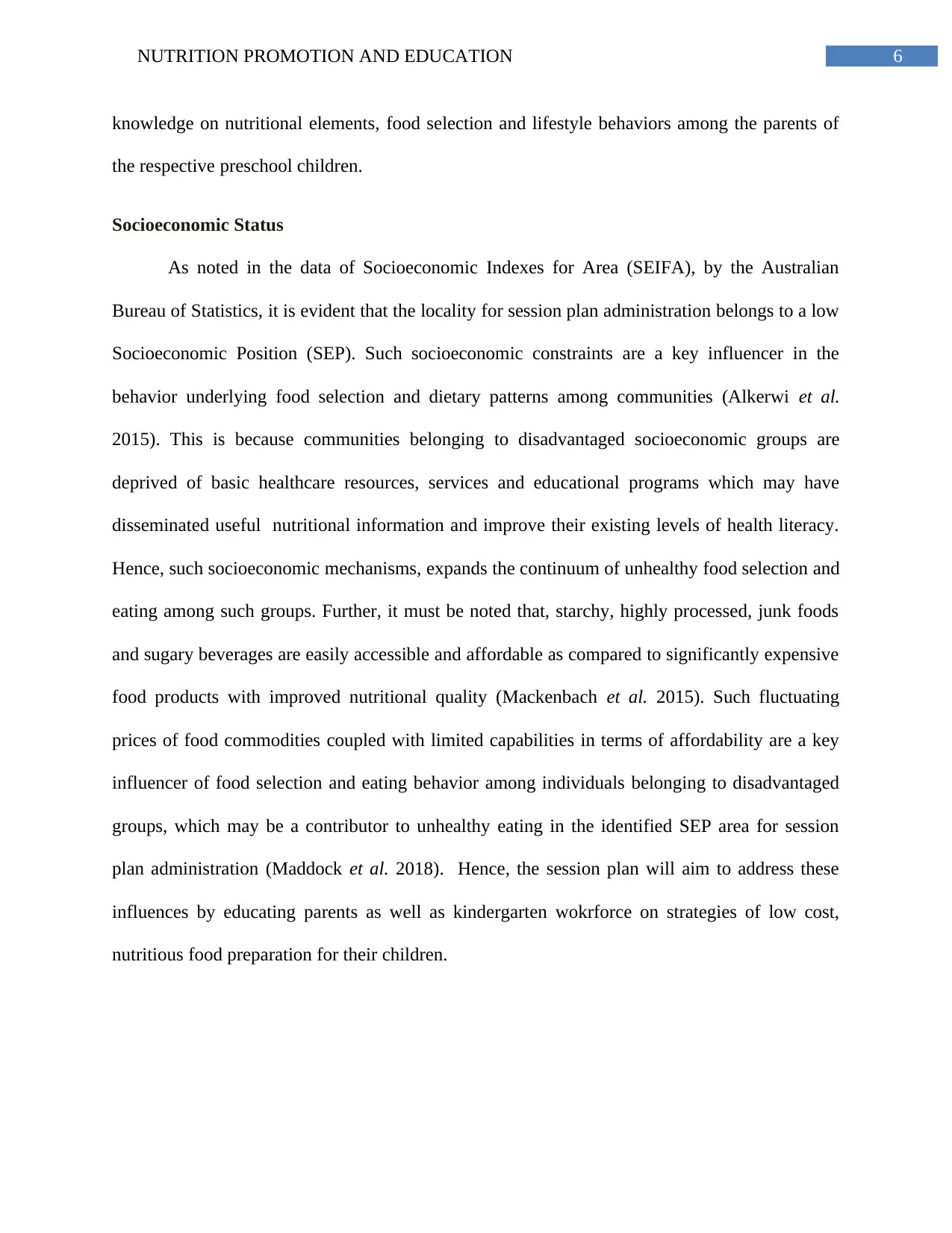
6NUTRITION PROMOTION AND EDUCATION
knowledge on nutritional elements, food selection and lifestyle behaviors among the parents of
the respective preschool children.
Socioeconomic Status
As noted in the data of Socioeconomic Indexes for Area (SEIFA), by the Australian
Bureau of Statistics, it is evident that the locality for session plan administration belongs to a low
Socioeconomic Position (SEP). Such socioeconomic constraints are a key influencer in the
behavior underlying food selection and dietary patterns among communities (Alkerwi et al.
2015). This is because communities belonging to disadvantaged socioeconomic groups are
deprived of basic healthcare resources, services and educational programs which may have
disseminated useful nutritional information and improve their existing levels of health literacy.
Hence, such socioeconomic mechanisms, expands the continuum of unhealthy food selection and
eating among such groups. Further, it must be noted that, starchy, highly processed, junk foods
and sugary beverages are easily accessible and affordable as compared to significantly expensive
food products with improved nutritional quality (Mackenbach et al. 2015). Such fluctuating
prices of food commodities coupled with limited capabilities in terms of affordability are a key
influencer of food selection and eating behavior among individuals belonging to disadvantaged
groups, which may be a contributor to unhealthy eating in the identified SEP area for session
plan administration (Maddock et al. 2018). Hence, the session plan will aim to address these
influences by educating parents as well as kindergarten wokrforce on strategies of low cost,
nutritious food preparation for their children.
knowledge on nutritional elements, food selection and lifestyle behaviors among the parents of
the respective preschool children.
Socioeconomic Status
As noted in the data of Socioeconomic Indexes for Area (SEIFA), by the Australian
Bureau of Statistics, it is evident that the locality for session plan administration belongs to a low
Socioeconomic Position (SEP). Such socioeconomic constraints are a key influencer in the
behavior underlying food selection and dietary patterns among communities (Alkerwi et al.
2015). This is because communities belonging to disadvantaged socioeconomic groups are
deprived of basic healthcare resources, services and educational programs which may have
disseminated useful nutritional information and improve their existing levels of health literacy.
Hence, such socioeconomic mechanisms, expands the continuum of unhealthy food selection and
eating among such groups. Further, it must be noted that, starchy, highly processed, junk foods
and sugary beverages are easily accessible and affordable as compared to significantly expensive
food products with improved nutritional quality (Mackenbach et al. 2015). Such fluctuating
prices of food commodities coupled with limited capabilities in terms of affordability are a key
influencer of food selection and eating behavior among individuals belonging to disadvantaged
groups, which may be a contributor to unhealthy eating in the identified SEP area for session
plan administration (Maddock et al. 2018). Hence, the session plan will aim to address these
influences by educating parents as well as kindergarten wokrforce on strategies of low cost,
nutritious food preparation for their children.
Paraphrase This Document
Need a fresh take? Get an instant paraphrase of this document with our AI Paraphraser
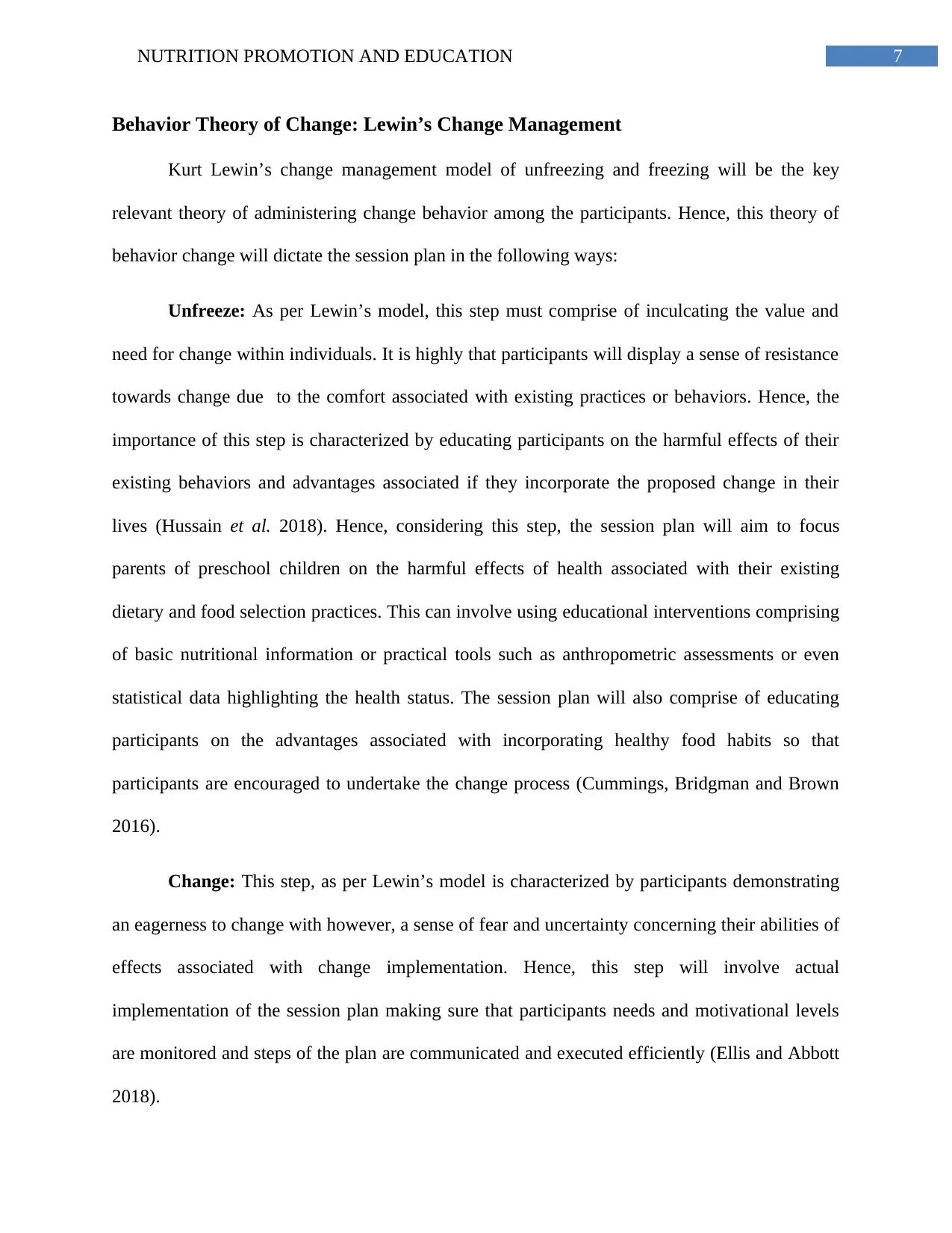
7NUTRITION PROMOTION AND EDUCATION
Behavior Theory of Change: Lewin’s Change Management
Kurt Lewin’s change management model of unfreezing and freezing will be the key
relevant theory of administering change behavior among the participants. Hence, this theory of
behavior change will dictate the session plan in the following ways:
Unfreeze: As per Lewin’s model, this step must comprise of inculcating the value and
need for change within individuals. It is highly that participants will display a sense of resistance
towards change due to the comfort associated with existing practices or behaviors. Hence, the
importance of this step is characterized by educating participants on the harmful effects of their
existing behaviors and advantages associated if they incorporate the proposed change in their
lives (Hussain et al. 2018). Hence, considering this step, the session plan will aim to focus
parents of preschool children on the harmful effects of health associated with their existing
dietary and food selection practices. This can involve using educational interventions comprising
of basic nutritional information or practical tools such as anthropometric assessments or even
statistical data highlighting the health status. The session plan will also comprise of educating
participants on the advantages associated with incorporating healthy food habits so that
participants are encouraged to undertake the change process (Cummings, Bridgman and Brown
2016).
Change: This step, as per Lewin’s model is characterized by participants demonstrating
an eagerness to change with however, a sense of fear and uncertainty concerning their abilities of
effects associated with change implementation. Hence, this step will involve actual
implementation of the session plan making sure that participants needs and motivational levels
are monitored and steps of the plan are communicated and executed efficiently (Ellis and Abbott
2018).
Behavior Theory of Change: Lewin’s Change Management
Kurt Lewin’s change management model of unfreezing and freezing will be the key
relevant theory of administering change behavior among the participants. Hence, this theory of
behavior change will dictate the session plan in the following ways:
Unfreeze: As per Lewin’s model, this step must comprise of inculcating the value and
need for change within individuals. It is highly that participants will display a sense of resistance
towards change due to the comfort associated with existing practices or behaviors. Hence, the
importance of this step is characterized by educating participants on the harmful effects of their
existing behaviors and advantages associated if they incorporate the proposed change in their
lives (Hussain et al. 2018). Hence, considering this step, the session plan will aim to focus
parents of preschool children on the harmful effects of health associated with their existing
dietary and food selection practices. This can involve using educational interventions comprising
of basic nutritional information or practical tools such as anthropometric assessments or even
statistical data highlighting the health status. The session plan will also comprise of educating
participants on the advantages associated with incorporating healthy food habits so that
participants are encouraged to undertake the change process (Cummings, Bridgman and Brown
2016).
Change: This step, as per Lewin’s model is characterized by participants demonstrating
an eagerness to change with however, a sense of fear and uncertainty concerning their abilities of
effects associated with change implementation. Hence, this step will involve actual
implementation of the session plan making sure that participants needs and motivational levels
are monitored and steps of the plan are communicated and executed efficiently (Ellis and Abbott
2018).
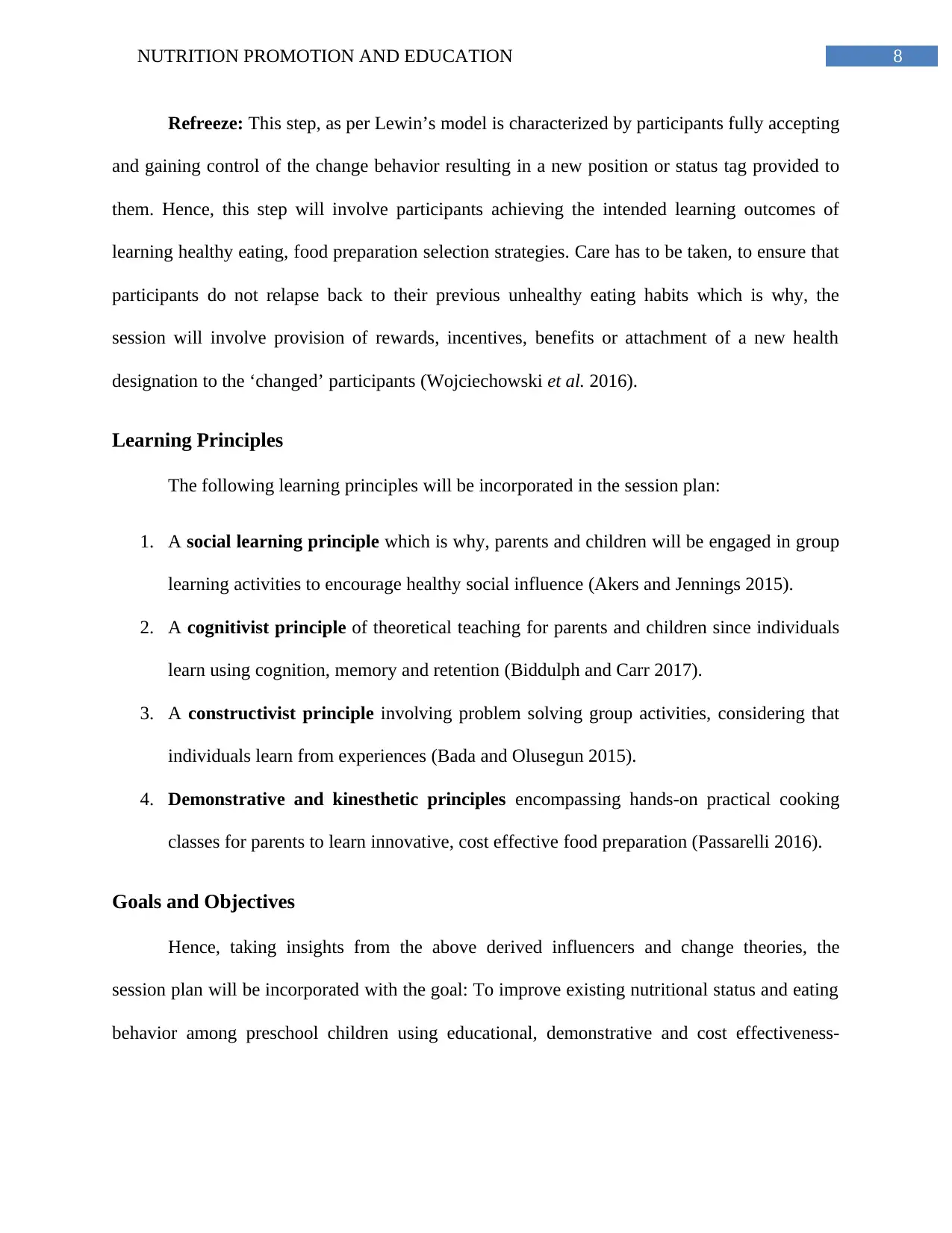
8NUTRITION PROMOTION AND EDUCATION
Refreeze: This step, as per Lewin’s model is characterized by participants fully accepting
and gaining control of the change behavior resulting in a new position or status tag provided to
them. Hence, this step will involve participants achieving the intended learning outcomes of
learning healthy eating, food preparation selection strategies. Care has to be taken, to ensure that
participants do not relapse back to their previous unhealthy eating habits which is why, the
session will involve provision of rewards, incentives, benefits or attachment of a new health
designation to the ‘changed’ participants (Wojciechowski et al. 2016).
Learning Principles
The following learning principles will be incorporated in the session plan:
1. A social learning principle which is why, parents and children will be engaged in group
learning activities to encourage healthy social influence (Akers and Jennings 2015).
2. A cognitivist principle of theoretical teaching for parents and children since individuals
learn using cognition, memory and retention (Biddulph and Carr 2017).
3. A constructivist principle involving problem solving group activities, considering that
individuals learn from experiences (Bada and Olusegun 2015).
4. Demonstrative and kinesthetic principles encompassing hands-on practical cooking
classes for parents to learn innovative, cost effective food preparation (Passarelli 2016).
Goals and Objectives
Hence, taking insights from the above derived influencers and change theories, the
session plan will be incorporated with the goal: To improve existing nutritional status and eating
behavior among preschool children using educational, demonstrative and cost effectiveness-
Refreeze: This step, as per Lewin’s model is characterized by participants fully accepting
and gaining control of the change behavior resulting in a new position or status tag provided to
them. Hence, this step will involve participants achieving the intended learning outcomes of
learning healthy eating, food preparation selection strategies. Care has to be taken, to ensure that
participants do not relapse back to their previous unhealthy eating habits which is why, the
session will involve provision of rewards, incentives, benefits or attachment of a new health
designation to the ‘changed’ participants (Wojciechowski et al. 2016).
Learning Principles
The following learning principles will be incorporated in the session plan:
1. A social learning principle which is why, parents and children will be engaged in group
learning activities to encourage healthy social influence (Akers and Jennings 2015).
2. A cognitivist principle of theoretical teaching for parents and children since individuals
learn using cognition, memory and retention (Biddulph and Carr 2017).
3. A constructivist principle involving problem solving group activities, considering that
individuals learn from experiences (Bada and Olusegun 2015).
4. Demonstrative and kinesthetic principles encompassing hands-on practical cooking
classes for parents to learn innovative, cost effective food preparation (Passarelli 2016).
Goals and Objectives
Hence, taking insights from the above derived influencers and change theories, the
session plan will be incorporated with the goal: To improve existing nutritional status and eating
behavior among preschool children using educational, demonstrative and cost effectiveness-
⊘ This is a preview!⊘
Do you want full access?
Subscribe today to unlock all pages.

Trusted by 1+ million students worldwide
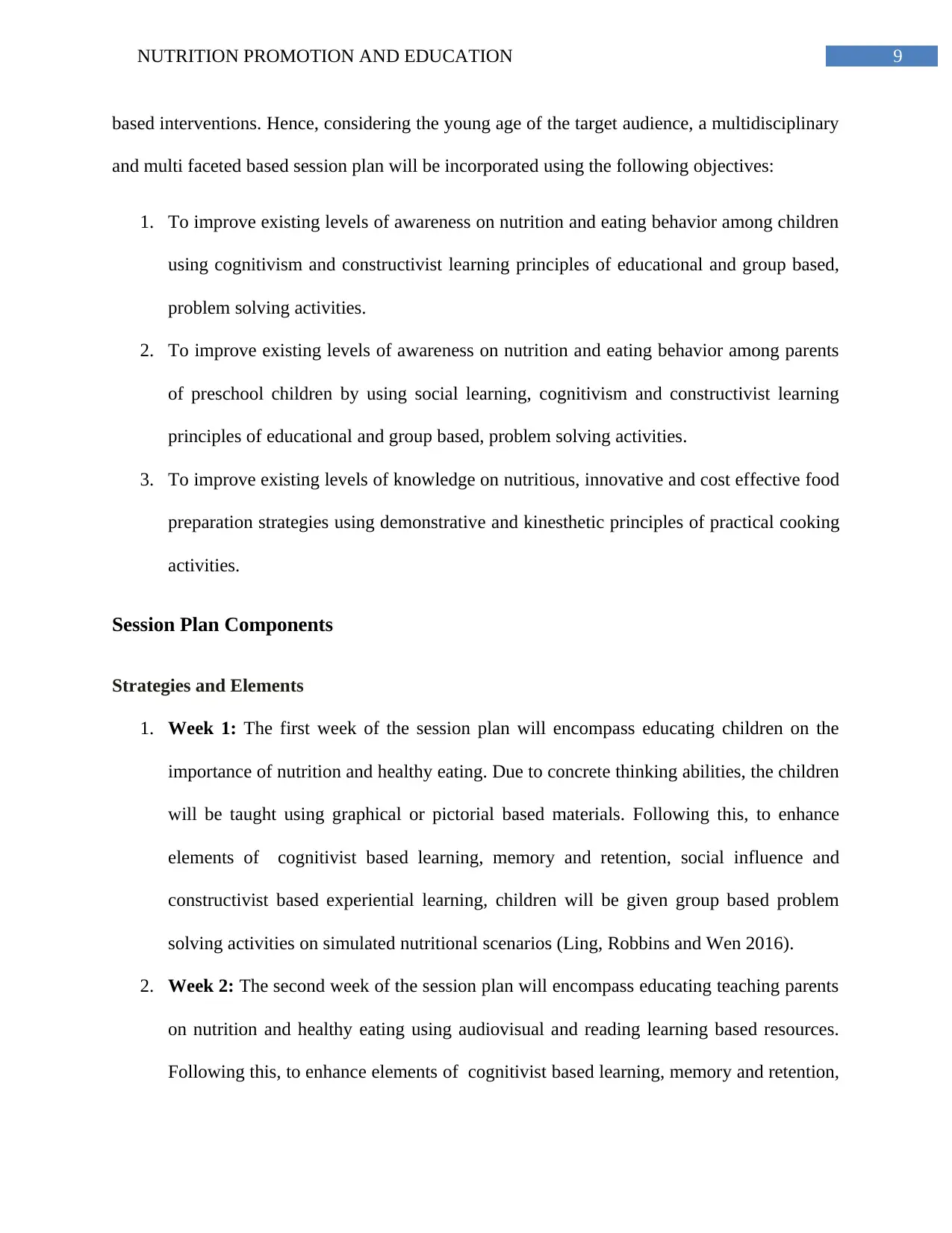
9NUTRITION PROMOTION AND EDUCATION
based interventions. Hence, considering the young age of the target audience, a multidisciplinary
and multi faceted based session plan will be incorporated using the following objectives:
1. To improve existing levels of awareness on nutrition and eating behavior among children
using cognitivism and constructivist learning principles of educational and group based,
problem solving activities.
2. To improve existing levels of awareness on nutrition and eating behavior among parents
of preschool children by using social learning, cognitivism and constructivist learning
principles of educational and group based, problem solving activities.
3. To improve existing levels of knowledge on nutritious, innovative and cost effective food
preparation strategies using demonstrative and kinesthetic principles of practical cooking
activities.
Session Plan Components
Strategies and Elements
1. Week 1: The first week of the session plan will encompass educating children on the
importance of nutrition and healthy eating. Due to concrete thinking abilities, the children
will be taught using graphical or pictorial based materials. Following this, to enhance
elements of cognitivist based learning, memory and retention, social influence and
constructivist based experiential learning, children will be given group based problem
solving activities on simulated nutritional scenarios (Ling, Robbins and Wen 2016).
2. Week 2: The second week of the session plan will encompass educating teaching parents
on nutrition and healthy eating using audiovisual and reading learning based resources.
Following this, to enhance elements of cognitivist based learning, memory and retention,
based interventions. Hence, considering the young age of the target audience, a multidisciplinary
and multi faceted based session plan will be incorporated using the following objectives:
1. To improve existing levels of awareness on nutrition and eating behavior among children
using cognitivism and constructivist learning principles of educational and group based,
problem solving activities.
2. To improve existing levels of awareness on nutrition and eating behavior among parents
of preschool children by using social learning, cognitivism and constructivist learning
principles of educational and group based, problem solving activities.
3. To improve existing levels of knowledge on nutritious, innovative and cost effective food
preparation strategies using demonstrative and kinesthetic principles of practical cooking
activities.
Session Plan Components
Strategies and Elements
1. Week 1: The first week of the session plan will encompass educating children on the
importance of nutrition and healthy eating. Due to concrete thinking abilities, the children
will be taught using graphical or pictorial based materials. Following this, to enhance
elements of cognitivist based learning, memory and retention, social influence and
constructivist based experiential learning, children will be given group based problem
solving activities on simulated nutritional scenarios (Ling, Robbins and Wen 2016).
2. Week 2: The second week of the session plan will encompass educating teaching parents
on nutrition and healthy eating using audiovisual and reading learning based resources.
Following this, to enhance elements of cognitivist based learning, memory and retention,
Paraphrase This Document
Need a fresh take? Get an instant paraphrase of this document with our AI Paraphraser
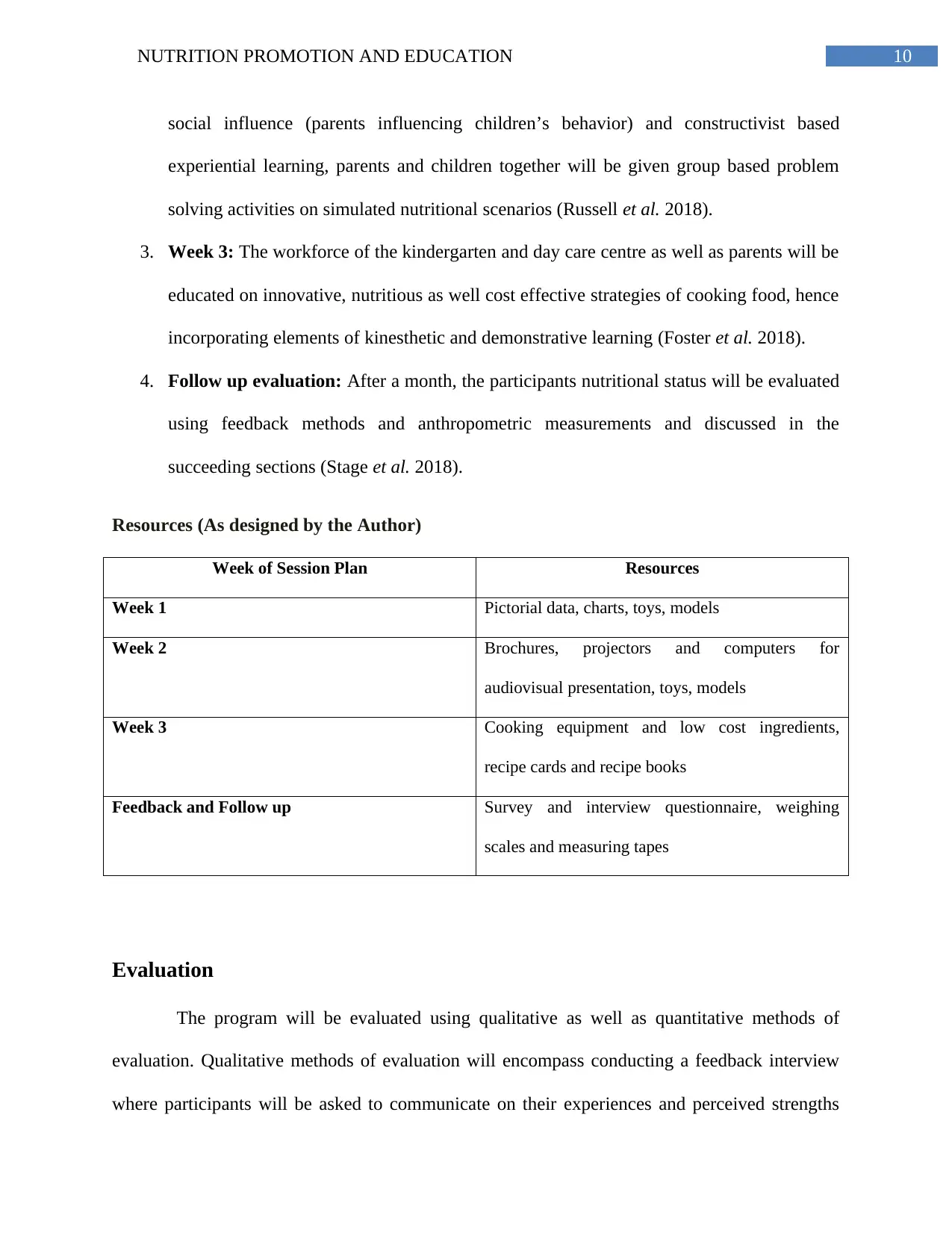
10NUTRITION PROMOTION AND EDUCATION
social influence (parents influencing children’s behavior) and constructivist based
experiential learning, parents and children together will be given group based problem
solving activities on simulated nutritional scenarios (Russell et al. 2018).
3. Week 3: The workforce of the kindergarten and day care centre as well as parents will be
educated on innovative, nutritious as well cost effective strategies of cooking food, hence
incorporating elements of kinesthetic and demonstrative learning (Foster et al. 2018).
4. Follow up evaluation: After a month, the participants nutritional status will be evaluated
using feedback methods and anthropometric measurements and discussed in the
succeeding sections (Stage et al. 2018).
Resources (As designed by the Author)
Week of Session Plan Resources
Week 1 Pictorial data, charts, toys, models
Week 2 Brochures, projectors and computers for
audiovisual presentation, toys, models
Week 3 Cooking equipment and low cost ingredients,
recipe cards and recipe books
Feedback and Follow up Survey and interview questionnaire, weighing
scales and measuring tapes
Evaluation
The program will be evaluated using qualitative as well as quantitative methods of
evaluation. Qualitative methods of evaluation will encompass conducting a feedback interview
where participants will be asked to communicate on their experiences and perceived strengths
social influence (parents influencing children’s behavior) and constructivist based
experiential learning, parents and children together will be given group based problem
solving activities on simulated nutritional scenarios (Russell et al. 2018).
3. Week 3: The workforce of the kindergarten and day care centre as well as parents will be
educated on innovative, nutritious as well cost effective strategies of cooking food, hence
incorporating elements of kinesthetic and demonstrative learning (Foster et al. 2018).
4. Follow up evaluation: After a month, the participants nutritional status will be evaluated
using feedback methods and anthropometric measurements and discussed in the
succeeding sections (Stage et al. 2018).
Resources (As designed by the Author)
Week of Session Plan Resources
Week 1 Pictorial data, charts, toys, models
Week 2 Brochures, projectors and computers for
audiovisual presentation, toys, models
Week 3 Cooking equipment and low cost ingredients,
recipe cards and recipe books
Feedback and Follow up Survey and interview questionnaire, weighing
scales and measuring tapes
Evaluation
The program will be evaluated using qualitative as well as quantitative methods of
evaluation. Qualitative methods of evaluation will encompass conducting a feedback interview
where participants will be asked to communicate on their experiences and perceived strengths
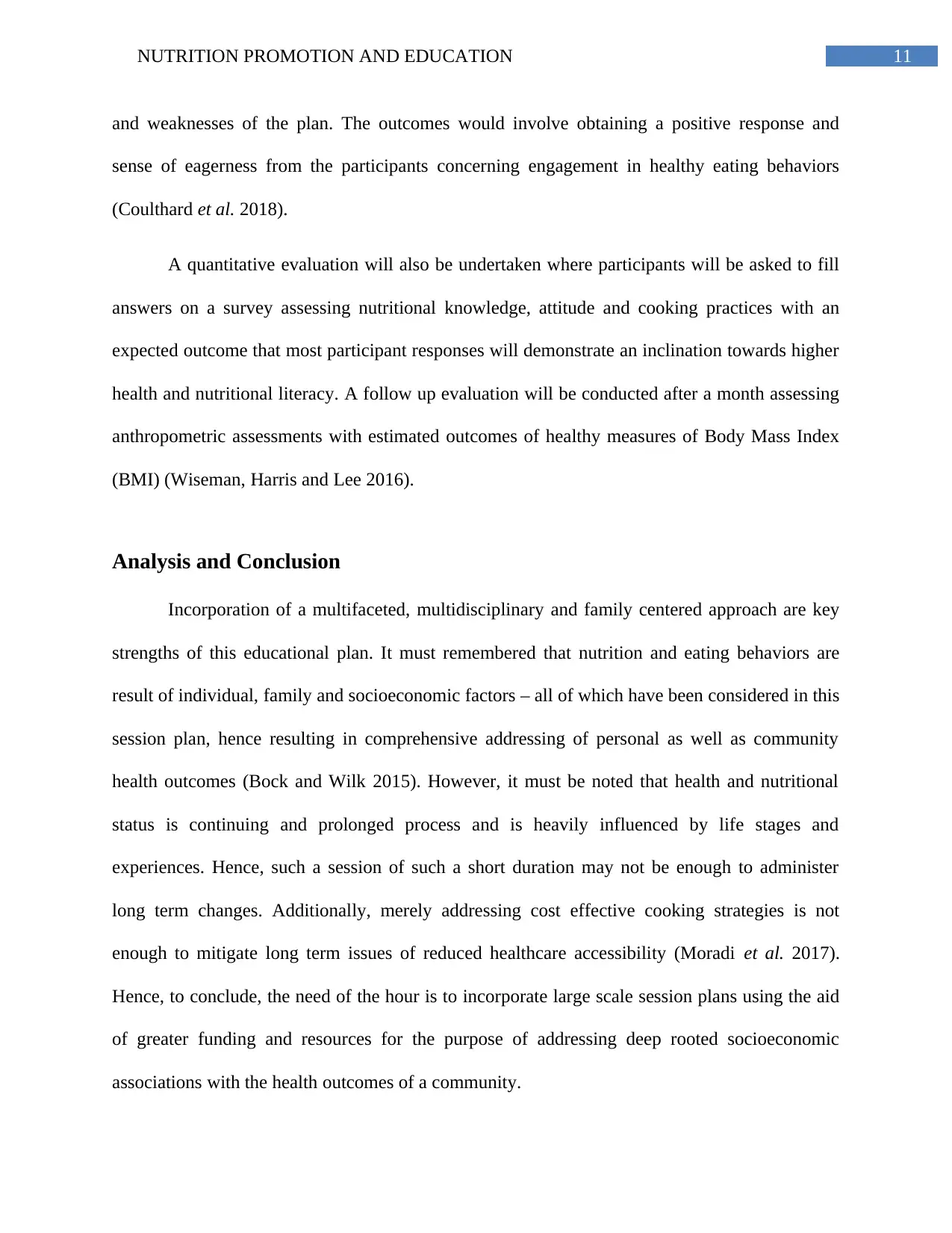
11NUTRITION PROMOTION AND EDUCATION
and weaknesses of the plan. The outcomes would involve obtaining a positive response and
sense of eagerness from the participants concerning engagement in healthy eating behaviors
(Coulthard et al. 2018).
A quantitative evaluation will also be undertaken where participants will be asked to fill
answers on a survey assessing nutritional knowledge, attitude and cooking practices with an
expected outcome that most participant responses will demonstrate an inclination towards higher
health and nutritional literacy. A follow up evaluation will be conducted after a month assessing
anthropometric assessments with estimated outcomes of healthy measures of Body Mass Index
(BMI) (Wiseman, Harris and Lee 2016).
Analysis and Conclusion
Incorporation of a multifaceted, multidisciplinary and family centered approach are key
strengths of this educational plan. It must remembered that nutrition and eating behaviors are
result of individual, family and socioeconomic factors – all of which have been considered in this
session plan, hence resulting in comprehensive addressing of personal as well as community
health outcomes (Bock and Wilk 2015). However, it must be noted that health and nutritional
status is continuing and prolonged process and is heavily influenced by life stages and
experiences. Hence, such a session of such a short duration may not be enough to administer
long term changes. Additionally, merely addressing cost effective cooking strategies is not
enough to mitigate long term issues of reduced healthcare accessibility (Moradi et al. 2017).
Hence, to conclude, the need of the hour is to incorporate large scale session plans using the aid
of greater funding and resources for the purpose of addressing deep rooted socioeconomic
associations with the health outcomes of a community.
and weaknesses of the plan. The outcomes would involve obtaining a positive response and
sense of eagerness from the participants concerning engagement in healthy eating behaviors
(Coulthard et al. 2018).
A quantitative evaluation will also be undertaken where participants will be asked to fill
answers on a survey assessing nutritional knowledge, attitude and cooking practices with an
expected outcome that most participant responses will demonstrate an inclination towards higher
health and nutritional literacy. A follow up evaluation will be conducted after a month assessing
anthropometric assessments with estimated outcomes of healthy measures of Body Mass Index
(BMI) (Wiseman, Harris and Lee 2016).
Analysis and Conclusion
Incorporation of a multifaceted, multidisciplinary and family centered approach are key
strengths of this educational plan. It must remembered that nutrition and eating behaviors are
result of individual, family and socioeconomic factors – all of which have been considered in this
session plan, hence resulting in comprehensive addressing of personal as well as community
health outcomes (Bock and Wilk 2015). However, it must be noted that health and nutritional
status is continuing and prolonged process and is heavily influenced by life stages and
experiences. Hence, such a session of such a short duration may not be enough to administer
long term changes. Additionally, merely addressing cost effective cooking strategies is not
enough to mitigate long term issues of reduced healthcare accessibility (Moradi et al. 2017).
Hence, to conclude, the need of the hour is to incorporate large scale session plans using the aid
of greater funding and resources for the purpose of addressing deep rooted socioeconomic
associations with the health outcomes of a community.
⊘ This is a preview!⊘
Do you want full access?
Subscribe today to unlock all pages.

Trusted by 1+ million students worldwide
1 out of 17
Related Documents
Your All-in-One AI-Powered Toolkit for Academic Success.
+13062052269
info@desklib.com
Available 24*7 on WhatsApp / Email
![[object Object]](/_next/static/media/star-bottom.7253800d.svg)
Unlock your academic potential
Copyright © 2020–2025 A2Z Services. All Rights Reserved. Developed and managed by ZUCOL.





